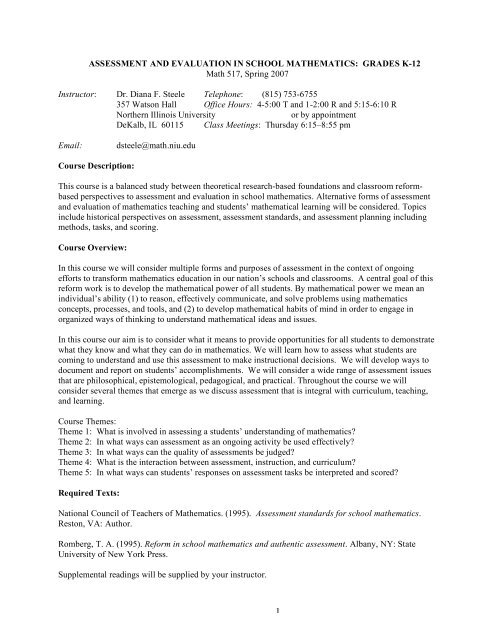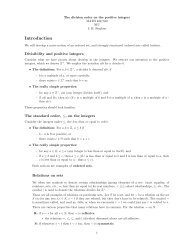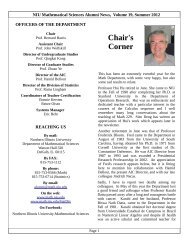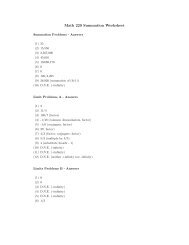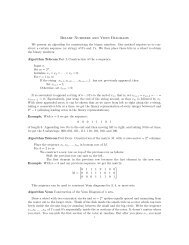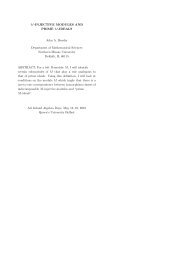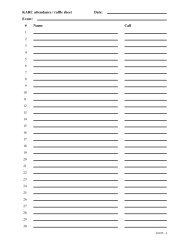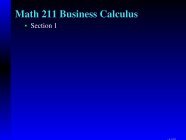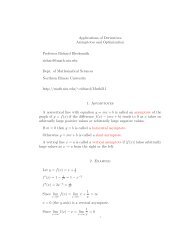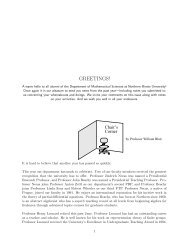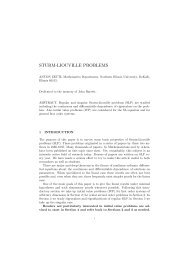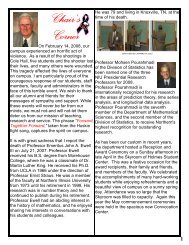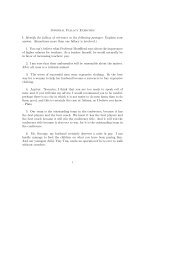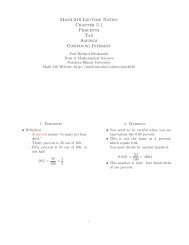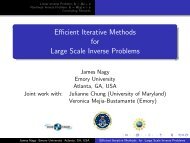ASSESSMENT AND EVALUATION IN SCHOOL MATHEMATICS ...
ASSESSMENT AND EVALUATION IN SCHOOL MATHEMATICS ...
ASSESSMENT AND EVALUATION IN SCHOOL MATHEMATICS ...
You also want an ePaper? Increase the reach of your titles
YUMPU automatically turns print PDFs into web optimized ePapers that Google loves.
Course Evaluation:Your grade will be determined on a point basis as outlined below.Class Discussion FacilitatorAssessment InterviewTask/Assessment/PresentationReflective WritingAttendance and ParticipationFinal Exam15 points25 points25 points10 points5 points20 points100 pointsGrading:90 points and above A80-90 points B70-80 points CCourse Assignments:Class Discussion Facilitator. (date and readings to be determined) You will lead the class discussion ofthe assigned readings for one class session during the semester. You will prepare questions in advance ofthe session that will illuminate and generate discussion on the themes and issues raised in the assignedreadings. You will prepare a typed set of the questions which you will give to everyone in class at thebeginning of the discussion.Assessment Interview. You will assess one student’s understanding of mathematics concepts in onecontent domain of your choice through an assessment interview. You will prepare an interview protocolcontaining assessment items for one student at a grade level of your choice. You will share the protocol inclass and submit the protocol to me for comments prior to using it. You will then conduct the interviewand write a report that includes your interpretation of the student’s responses using evidence from theinterview to support your conclusions. You will suggest an instructional program for the student based onthe information you gathered during the interview.Preparation of performance task/assessment/class presentation. You will prepare an assessment task (or aset of tasks) that assesses students’ mathematical knowledge in one content domain of your choice. Youwill prepare the accompanying scoring rubric(s). You will ask a class of students to complete the task(s)and score student responses according to your rubric(s). You will present the results during a classpresentation in which you share the task(s) and rubric(s), particular student responses, your interpretationof these responses, and changes you might make for the next time you use this assessment.Reflective Writing. Writing should be incorporated as part of the ongoing activities in the mathematicsclassroom. We will experiment with writing in our course as a vehicle for learning about mathematicsassessment and reflecting on what we are thinking and learning about the themes and issues around whichthe course is organized. You will write (and type, double spaced) each week about your own sensemakingof the readings for that session. The aim is to provide a formal way for you to critically reflectabout the ideas that emerge through the course readings and activities. I will collect your writing eachweek and will respond to your writing with my own written feedback. I would prefer the reflectivewritings done out of class be typed.2
Final Exam. The final exam is a collection of assessment tasks that assess students’ mathematicalknowledge in content domains of your choice. You will prepare five tasks (or five sets of tasks) andaccompanying scoring rubrics. Do not use tasks from class discussions and presentations or tasks that youhave prepared for other courses. Include the following for each task (or set of tasks): (1) the original taskand the source of the task; (2) the task with your modifications; and (3) the scoring rubric.Schedule for Assignments:Reflective Writings—Ongoing except the session in which you are class discussionClass discussion facilitators (one person per session): (dates to be announced)Preparation of Student Assessment Interview—February 22Student Interview Report Due— March 22Assessment Presentation—March 29 and April 5, 12, 19, 26 and May 3Final exam: Assessment Tasks/Rubrics—May 10Readings Schedule for JanuarySession Date Topic1 Jan. 18 Assessment through classroom discourseWilcox, S. K., & Lanier, P. E. (Eds.). (2000). Listening to students. Usingassessment to reshape mathematics teaching: A casebook for teachers and teachereducators, curriculum and staff development specialists, pp. 1–24. Mahwah, NJ:Erlbaum.2 Jan. 27 What is assessment? What is involved in assessing a student’sunderstanding of mathematics?Lederman, N., & Niess, M. (1999). Rubric's cube. School Science andMathematics, 113-115.NCTM Assessment Standards, pp. 1–22, 82–83Shepard, L. A. (2000). The role of assessment in a learning culture. EducationalResearcher 29, 4–14.Readings Schedule for FebruarySession Date Topic3 Feb. 1 What is assessment? What is involved in assessing a student’sunderstanding of mathematics? (cont’d)Purposes of assessment• NCTM Assessment Standards, pp. 25–65• NCTM Principles and Standards (2000), Assessment Principle• Lambdin, D. V. (1993). The NCTM’s 1989 evaluation standards: Recycledideas whose time has come? In N. L. Webb (Ed.), Assessment in themathematics classroom, pp. 7–15. Reston, VA: NCTM.• Wilson, L. D., & Kenney, P. A. (2003). Classroom and large-scaleassessment. In J. Kilpatrick, W. G. Martin, & D. Schifter (Eds.), Aresearch companion to Principles and Standards for School Mathematics,pp. 53–67. Reston, VA: National Council of Teachers of Mathematics.3
4 Feb. 8 Purposes of assessment (cont’d)Classroom and large-scale assessment• Black, P., & Wiliam, D. (1998). Inside the black box. Phi Delta Kappan80(2), 139–148. (Download from NIU Libraries: http://niulib.niu.edu.Select “Articles and More.” Under Social Sciences, select Education.Select either ERIC (CSA) or ERIC (FirstSearch). Enter authors’ lastnames with the word “and” between them. Caution—Wiliam is spelledwith only one “L.”)• Romberg, Chapter 1: Romberg, T. A., & Wilson, L. D. Issues related tothe development of an authentic assessment system for schoolmathematics, pp. 1–18.• Romberg, Chapter 2: Lajoie, S. P. A framework for authentic assessmentin mathematics, pp. 19–37.5 Feb. 15 Classroom and large-scale assessment (cont’d)Assessment tasks• Romberg, Chapter 3, Silver, E. A., & Kenney, P. A. Sources of assessmentinformation for instructional guidance in mathematics, pp. 38–86.• Stein, J. K., & Smith, M. S. (1998). Mathematical tasks as a frameworkfor reflection: From research to practice. Mathematics Teaching in theMiddle School, 3, 268-275.• Stein, M. K., Smith, M. S., Hennigsen, M. A., & Silver, E. A. (2000).Implementing standards-based mathematics instruction: A casebook forprofessional development. Using algebra tiles to multiply monomials andbinomials (p. 96-104). New York, NY: Teachers College Press.6 Feb. 22 Assessment tasks (cont’d)Assessment planning• Romberg, Chapter 4: de Lange, J. No change without problems, pp. 87–172.• Dekker, T., & Querelle, N. (2002). The great assessment problems book (GAP).Utrecht, The Netherlands: Freudenthal Institute. Chapters 1-5 and 10. Availablefor downloading at www.fi.uu.nl/catch/(Scroll down on the web page and select “all twelve chapters.” Then select theassigned chapters. If you have trouble downloading these chapters (they areWord documents), let me know and I will send them to you as attachments toemail.Readings Schedule for MarchSession Date Topic7 March 1 Interviews• Ginsburg, H. (1991). The clinical interview in psychological research onmathematical thinking: Aims, rationales, techniques. For the Learningof Mathematics, 1, 4-11.• Ginsburg, H. P., Jacobs, S. F., & Lopez, L. S. (1998). The teacher’sguide to flexible interviewing in the classroom: Learning what childrenknow about math (pp. 65-84). Needham Heights, MA: Allyn & Bacon.• Daniels, D. (2002). Understanding children: An interview andobservation guide for educators (pp. 19-23). NY: Mc Graw Hill.4
• Charles, R., Lester, F., & O’Daffer, P. (1987). How to evaluateprogress in problem solving (pp. 20–23). Reston, VA: NCTM.8 March 8 Assessment Tasks and Planning• Shafer, M. C., & Romberg, T. A. (1999). Assessment in classroomsthat promote understanding of mathematics. In E. Fennema & T. A.Romberg (Eds.), Teaching and learning mathematics with understanding(pp. 159–184.) Mahwah, NJ: Erlbaum.• Cai, J., Lane, S., & Jakabcsin, M. S. (1996). The role of openendedtasks and holistic scoring rubrics. In P. C. Elliott (Ed.),Communication in mathematics, K-12 and beyond (pp. 137–145).Reston, VA: NCTM.9 March 22 Scoring Rubrics• Porter, A. C. (2002). Measuring the content of instruction: Uses inresearch and practice. Educational Researcher, 31, 3-14. .(Download from NIU Libraries: http://niulib.niu.edu.Select “Does the library have this journal.” Select e-journals; type inEducational Researcher. Do search. You will get JSTOR information tofill in. Put 2002 for year; 31 for volume #; and 3 for start page. Do theand then click on article locator. Type in title and author. Dosearch.)• Charles, R., Lester, F., & O’Daffer, P. (1987). How to evaluateprogress in problem solving (pp. 29–41). Reston, VA: NCTM.• Dekker, T., & Querelle, N. (2002). The great assessment problemsbook (GAP). Utrecht, The Netherlands: Freudenthal Institute.Chapter 11. Available for reading and downloading atwww.fi.uu.nl/catch/10 March 29 Communication• Peressini, D., & Bassett, J. (1996). Mathematical communication instudents’ responses to a performance assessment task. In P. C. Elliott(Ed.), Communication in mathematics, K-12 and beyond, pp. 146–158.Reston, VA: NCTM.• Wijers, M. (April, 2000). Explanations why? The role of explanationsin answers to (assessment) problems. In de Lange (Chair), A Frameworkfor Classroom Assessment, Exemplified by Case Studies. Symposiumconducted at the annual meeting of the American Educational ResearchAssociation, New Orleans, LA.• Steele, Diana F. (2005). Using writing to help students developproblem-solving schemas for algebraic thinking. School Science andMathematics, 105, 142-154. (Download from NIU Libraries:http://niulib.niu.edu. Select “Articles and More.” Under Social Sciences,select Education. Select either ERIC (CSA) or ERIC (FirstSearch). Enterauthors’ last name)• Stonewater, J. K. (2002). The mathematics writer’s checklist: Thedevelopment of preliminary assessment tool for writing in mathematics.School Science and Mathematics, 102, 324-334. (Download from NIULibraries)5
Readings Schedule for AprilSession Date Topic11 April 5 Large-scale assessmentAssessing cooperative group problem solving• Romberg, Chapter 5, Stake, R. E. The invalidity of standardized testingfor measuring mathematical achievement. Sources of assessmentinformation for instructional guidance in mathematics, pp. 173-235.• Kroll, D. L., Masingila, J. O., Mau, S. T. (1992). Grading cooperativeproblem solving. Mathematics Teacher 85, pp. 619–627.• What’s in style? School Science and Mathematics, 98, p. 57-59.12 April 12 Large-scale assessmentObservation• Schorr, R. Y., Firestone, W. A., & Monfils, L. (2003). State testing andmathematics teaching in New Jersey: the effect of a text without othersupports. Journal for Research in Mathematics Education, 34, 373-405.• Clarke, D., & Wilson, L. (1994). Valuing what we see. MathematicsTeacher 87, pp. 542–545.• Vincent, M. L., & Wilson, L. (1996). Informal assessment: A story fromthe classroom. Mathematics Teacher 89, pp. 248–250.• Wilson, L. D. (1994). What gets graded is what gets valued. MathematicsTeacher 87, pp. 412–414.13 April 19 Large-scale assessmentPortfolios• Griffin, P., & Callingham, R. (2006). A 20-year study of mathematicsachievement. Journal for Research in Mathematics Education, 37, 167-186.• Lambdin, D. V., & Walker, V. L. (1994). Planning for classroomportfolio assessment. Arithmetic Teacher 41, 318–324. (Download from NIULibraries: http://niulib.niu.edu. Select Articles and More.” Under SocialSciences, select Education. Select ERIC (FirstSearch). Enter authors’ last nameswith the word and” between them).• Stenmark, J. K. (1991). Mathematics portfolios, pp. 35–44. Reston, VA:NCTM.• Kuhs, T. M. (1994). Portfolio assessment: Making it work for the firsttime. Mathematics Teacher, 87, 332-335.14 April 26 Large-scale assessmentAssessment Case• McGraw, R., Lubienski, S. T., & Strutchens, M. E. (2006). A closer lookat gender in NAEP mathematics achievement and affect data:Intersections with achievement, race/ethnicity, and socioeconomic status.Journal for Research in Mathematics Education, 37,129-150.• Merseth, K. K. (2003). Windows on teaching math: Cases of middle andsecondary classrooms. Ships in the fog (47-55). New York, NY: Teachers CollegePress.6
Readings Schedule for MaySession Date Topic15 May 3 Final Thoughts• Romberg, Chapter 7. Graue, M. E. Connecting visions of authenticassessment to the realities of educational practice, pp. 260–275.• Wilcox, S. K., & Jones, E. M. (2004). A tool for the teaching principle:Professional development through assessment. In R. N. Rubenstein & G.W. Bright (Ed.), Perspectives on the teaching of mathematics, Sixtysixthyearbook (pp. 239-258). Reston, VA: NCTM.7


